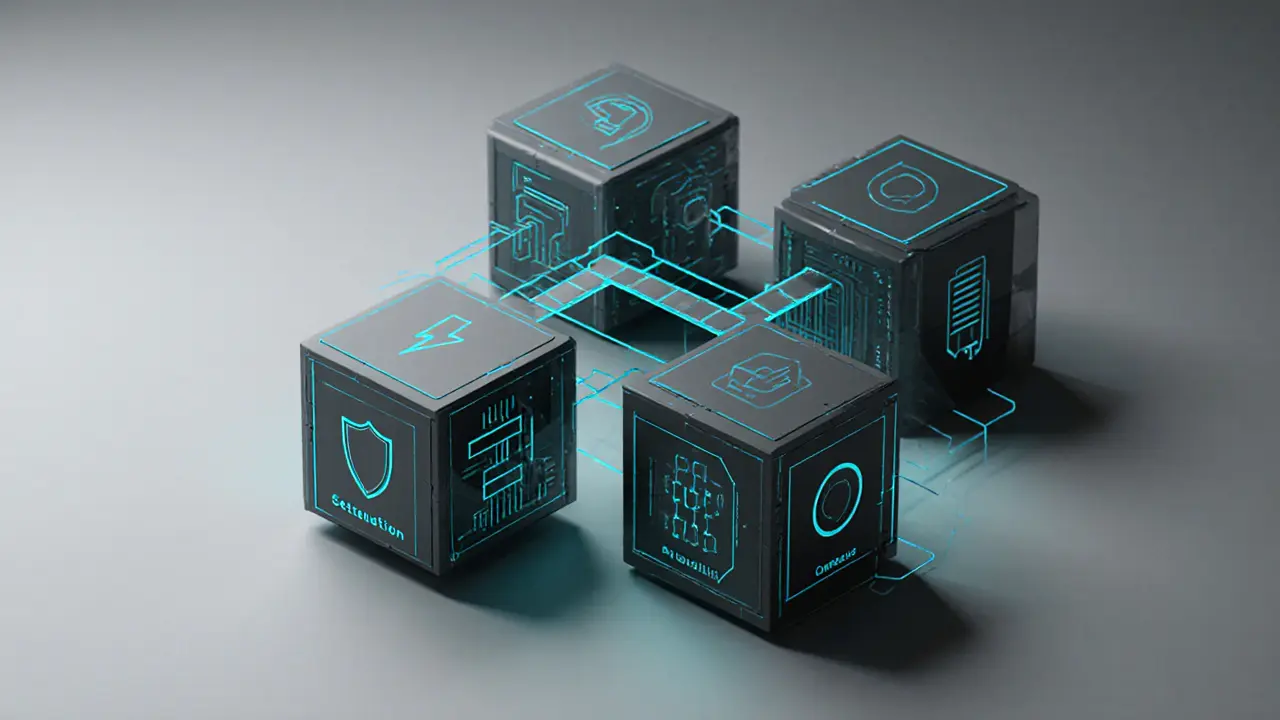Understanding Modular Blockchains: Architecture, Types, and Impact

Modular Blockchain Explorer
Selected Level Details
Monolithic
All core functions handled internally.
Typical projects: Bitcoin, Solana, Tron
Use case: Simple, single-chain apps; early-stage ecosystems
Benefits of Modular Design
Challenges of Modular Design
Key Projects
- Celestia: Focuses on data availability
- Optimism: Execution-only rollup
- Arbitrum: Similar execution environment
- ZkSync: Zero-knowledge proof execution
- Polygon Hermez: Zk-rollup execution with Ethereum settlement
Core Functions
- Execution Layer: Processes transactions and smart contracts
- Settlement Layer: Provides final, irreversible records
- Data Availability Layer: Stores and serves transaction data
- Consensus Layer: Coordinates network agreement
Quick Facts
- Modular blockchains split core functions (execution, settlement, data availability, consensus) into separate layers.
- Four main modularity levels exist: monolithic, polylithic, semi‑modular, and fully modular.
- Projects like Celestia (data availability) and Optimism (execution) illustrate the model.
- Benefits include higher throughput, lower hardware requirements, and customizable security.
- Challenges involve cross‑chain coordination and expanded attack surfaces.
What is a modular blockchain?
When you hear the term Modular Blockchain is an architecture that separates the four core blockchain duties-execution, settlement, data availability, and consensus-into dedicated, interoperable layers. Instead of forcing a single chain to do everything, each layer does one job really well and talks to the others through standardized interfaces.
This split‑up mirrors how modern internet services work: you wouldn’t expect a single server to host storage, compute, and DNS for every website. By pulling apart blockchain responsibilities, developers can pick the best‑fit solution for each piece, achieving orders of magnitude better performance.
Deconstructing the Core Functions
Understanding modular blockchains starts with the four pillars they break apart.
- Execution Layer processes user transactions and smart‑contract calls, turning intent into state changes.
- Settlement Layer provides the final, irreversible record of those state changes, acting like a supreme court for disputes.
- Data Availability Layer stores and serves the raw transaction data so validators can prove correctness without re‑downloading the entire chain history.
- Consensus Layer coordinates the network’s agreement on which block comes next, using mechanisms like Proof‑of‑Stake or Byzantine Fault Tolerance.
Each layer can be built by a different team, use a different tech stack, and even run on separate hardware, yet they all speak a common protocol to keep the whole system coherent.
Levels of Modularity
Not every blockchain splits all four duties. Researchers categorize four levels of modularity, ranging from “all‑in‑one” to fully disaggregated.
| Level | Core Functions Handled Internally | Typical Projects | Common Use Case |
|---|---|---|---|
| Monolithic | Execution, Settlement, Data Availability, Consensus | Bitcoin, Solana, Tron | Simple, single‑chain apps; early‑stage ecosystems |
| Polylithic | Execution + Settlement (base layer), Data Availability & Consensus shared across subnets | Cosmos, Avalanche, Polkadot | Heterogeneous multi‑chain networks with shared security |
| Semi‑Modular | Execution internal, Settlement or Data Availability outsourced | Ethereum (post‑sharding), Near, Mina, Tezos | Layer‑2‑ready chains that still run their own consensus |
| Fully Modular | Each function lives on a dedicated chain | Celestia (DA), Optimism (Execution), Arbitrum, ZkSync, Polygon Hermez | High‑throughput dApps needing custom stack composition |

Leading Projects and Real‑World Examples
Seeing modular concepts in action helps solidify the theory.
- Celestia focuses exclusively on data availability, letting other chains plug in for execution and consensus. Its developers claim a 100× boost in DA throughput compared to legacy layers.
- Optimism is an execution‑only rollup that posts transaction proofs to Ethereum for settlement and consensus.
- Arbitrum offers a similar execution environment, using fraud proofs to settle on Ethereum.
- ZkSync leverages zero‑knowledge proofs for execution, then relies on Ethereum for finality.
- Polygon Hermez combines zk‑rollup execution with Ethereum’s settlement layer.
- Dymension explores modularity beyond Celestia by offering customizable execution modules on top of its DA layer.
All of these projects share a common theme: they offload one or more heavy‑weight tasks to a specialist chain, letting the rest of the stack stay lightweight and fast.
Why Go Modular? Key Benefits
- Scalability: By optimizing each layer independently, networks can achieve throughput far beyond what a monolithic design permits. For example, a dedicated DA layer can handle terabytes of data per day without slowing down execution.
- Hardware Efficiency: Validators only need to run the parts they care about. An execution‑only rollup can be validated on a modest laptop, while a consensus‑focused chain can run on high‑end servers.
- Flexibility & Customization: Developers can mix‑and‑match components. Need ultra‑low latency? Pair a fast execution rollup with a high‑security settlement chain.
- Security Isolation: A breach in an execution layer doesn’t automatically compromise data availability or consensus, limiting the blast radius of attacks.
- Faster Innovation: Teams can iterate on their specialty without waiting for a monolith’s slow governance cycle.
Challenges and Trade‑offs
Modular designs aren’t a free lunch.
- Cross‑Chain Coordination: Multiple layers need reliable messaging bridges. Any lag or failure can stall finality.
- Expanded Attack Surface: Each additional chain introduces new vectors-bridge exploits, consensus mismatches, or data‑availability proofs.
- Complex User Experience: End‑users often see only the execution layer, but developers must handle settlement proofs and DA proofs behind the scenes.
- Standardization Gaps: The ecosystem still lacks universally adopted APIs for inter‑layer communication, though projects like IBC (Inter‑Blockchain Communication) aim to fill that void.
Future Outlook
Analysts from Binance Academy and Volt Capital predict that modular stack adoption will dominate new blockchain projects after 2025. Key trends to watch:
- Interoperability Protocols: Standards such as IBC and upcoming “Modular Bridge” specs will reduce friction between execution, settlement, and DA layers.
- Security Frameworks: Novel multi‑chain audit tools and formal verification methods will address the enlarged attack surface.
- Composable Ecosystems: Expect marketplaces where developers can “shop” for the best execution rollup, the most economical DA layer, and a consensus engine that meets their decentralization requirements.
- Regulatory Alignment: Modular designs may simplify compliance, as data‑availability components can be hosted in jurisdictions with favorable data‑storage laws while keeping consensus globally distributed.
In short, modular blockchains are positioning themselves as the backbone for the next wave of mass‑adopted decentralized applications-think social media platforms, gaming economies, and global finance services serving billions of users.
Frequently Asked Questions
What distinguishes a modular blockchain from a regular layer‑2 solution?
Layer‑2s like Optimism still rely on a single base chain (Ethereum) for all four core functions. A modular blockchain distributes those functions across separate specialized chains, allowing each to be independently optimized.
Do I need to run multiple nodes to interact with a modular stack?
Not necessarily. Most end‑users run a wallet that connects to the execution layer only. The wallet’s backend (or a third‑party provider) handles settlement proofs and fetches data from the DA layer.
Is security weaker because responsibilities are split?
Security is actually more compartmentalized. A breach in one layer doesn’t automatically compromise the others, but you do need robust bridge protocols and thorough audits for each integration point.
Can existing blockchains become modular without a hard fork?
Yes. Projects can spin off dedicated DA or execution layers and gradually route traffic through them. Ethereum’s roadmap, for example, envisions a multi‑layer architecture where rollups handle execution while Ethereum provides settlement and consensus.
What are the biggest players building modular components today?
Key players include Celestia (data availability), Optimism and Arbitrum (execution), ZkSync (zk‑rollup execution), Polygon Hermez (zk‑execution), and Dymension (customizable modular stacks).

John E Owren
October 4, 2025 AT 02:55Joseph Eckelkamp
October 4, 2025 AT 09:45Jennifer Rosada
October 4, 2025 AT 23:09adam pop
October 4, 2025 AT 23:59Dimitri Breiner
October 5, 2025 AT 00:53LeAnn Dolly-Powell
October 5, 2025 AT 23:58Anastasia Alamanou
October 6, 2025 AT 01:00Rohit Sreenath
October 6, 2025 AT 10:56Sam Kessler
October 7, 2025 AT 05:41Steve Roberts
October 7, 2025 AT 11:40